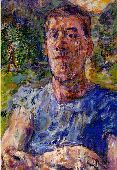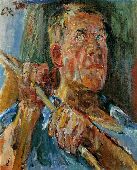Oskar Kokoschka |
|||
| Introduction | |||
 Oskar Kokoschka  Alma Mahler  Kokoschka 1937  Kokoschka 1948   |
Oskar Kokoschka was born on March 1, 1886 in Pöchlarn (at the Danube), Lower Austria. In the beginning of his career he was influenced very much by Gustav Klimt and the Wiener Secession and was assigned commissions by the association already during his time at the art school in Vienna. In his youth he designed post cards and posters, performed an Indian fairy-tale at the legendary "Cabaret Fledermaus" (he was part of the team there), was the author of dramas set to music by important composers (e.g. Gottfried von Einem, P. Hindemith und E. Krenek) and wrote the symbolic love story "Die träumenden Knaben" (The dreaming boys). In later years the universal genius created decorations for the Salzburg Festival and taught for years there at his "school of seeing". His bequest comprises more than 500 graphical works and more than 400 oil paintings. He studied at the "Wiener Kunstgewerbeschule" (Vienna School of Arts and Crafts) by A. v. Kenner, C. O. Czeschka und B. Löffler from 1905 to 1908. The love story "Die träumenden Knaben" was published in 1908 by the Wiener Werkstätte. The book which was illustrated by Kokoschka as well belonged to the art style predominant around 1900 which often had legends and fairy tales as its theme. Kokoschka dedicated this book to Gustav Klimt who he admired very much. In 1908, after publication of his book, there was a clear turning point in Kokoschka's life (similar to Egon Schiele). He freed himself from the artistic influences so far finding his own characteristic style with his ego playing an important role. Kokoschka became one of the most important representatives of expressionist art. At the "Kunstschau 1908" (Art Show 1908) his works were rejected and misunderstood though, the public was not yet mature for his art. Adolf Loos was one of his promoters - Kokoschka was assigned a number of commissions through him. And Klimt even called Kokoschka the greatest talent of the young generation. As an early exponent of the avant-garde expressionist movement, he began to paint psychologically penetrating portraits of Viennese physicians, architects, and artists. Among these works are Hans Tietze and Erica Tietze-Conrat (1909, Museum of Modern Art, New York City), August Forel (1910, Mannheim Art Gallery, Germany), and Self-Portrait (1913, Museum of Modern Art). In 1912 Alma Mahler (former wife of Gustav Mahler) met the young painter Oskar Kokoschka, who was known as the enfant terrible of the Viennese art scene. He was violent and unbridled, and the press derided him as »the wildest beast of all«. The acquaintanceship led on to an unrestrained amour fou, an intensive sexual relationship interrupted only during those hours when Alma posed as a model for her loved one. When he was not loving her, he painted her. Kokoschka´s consuming passion was soon transformed into subjugation, and his jealousy into obsession. Kokoschka´s mother rushed to her son´s assistance and wrote to Alma: "If you see Oskar again, I´ll shoot you dead!" Kokoschka´s most famous painting, "Die Windsbraut" (1914) (The Bride of the Wind), testifies to this anguished time. When Alma became pregnant by him but had the child aborted, she caused him such a blow that he was never able to recover from it. She sealed his physical downfall by sending him to the front as a volunteer, where he received a serious bayonet injury in Russia, in 1915, and diagnosed as psychologically unstable. But the news of Alma´s marriage to Walter Gropius hurt him still more. In deepest desperation, he ordered a life-size doll from a doll-maker in Munich which should resemble Alma in every detail, and he thought it would help him console himself for the loss of his loved one. Not surprisingly, the result was disappointing: a clumsy construction of fabric and wood-wool, which Kokoschka had beheaded at a wild, orgiastic party in his atelier in Dresden, in 1919. And so he separated himself from the curse of his life, Alma, in effigy form. In 1917 Kokoschka left Vienna for Dresden where he was professor at the Academy until 1924. During this time he painted The Power of Music (1919, Dresden Paintings Collection, Dresden). A succeeding seven-year period of travel in Europe, North Africa and the Middle East resulted in a number of robust, brilliantly coloured landscapes and figure pieces, painted with great freedom and exuberance. Many of them are views of harbours, mountains, and cities. Examples from this period include Harbour of Marseilles (1925, Saint Louis Art Museum, Saint Louis, Missouri), View of Cologne (1956, Wallraf-Richartz-Museum, Cologne), and Tower Bridge (1925-1926, Minneapolis Institute of Art, Minnesota). In 1931 where he was commissioned by the Vienna City Administration to paint a Viennese motive. (He chose the view of Vienna from Wilhelminenberg.) The great cycle of city and landscape paintings ("world landscapes") is unique in the art of the 20th century. In 1934 Kokoschka became professor at the Academy in Prague but was forced to emigrate to London in 1938. His works were exhibited as "degenerate art" in the Third Reich. In England, he painted antiwar pictures during World War II (1939-1945) and became a British subject in 1947. At this point he found his protégé, Ishbel McWhirter. Later he visited the United States and settled in Switzerland. Despite his expatriation he always had a close relation to Austria. In 1956, he was already world-famous then, he painted the Vienna State Opera reopened in 1955. He died on February 22, 1980 in Villeneuve near Montreux, Switzerland and was buried at "Clarens" cemetery near Montreux. He was famous for his psychological portraits in which the soul of the sitter was thought to be depicted bare. His literary works include poetry and plays not translated into English and a collection of short stories, A Sea Ringed with Visions (1956; translated 1962). Some of his most famous paintings
Museums in Austria Museum
moderner Kunst Stiftung Ludwig Wien Österreichische
Galerie Historisches
Museum der Stadt Wien Wiener
Albertina Hochschule
für angewandte Kunst Neue Galerie
der Stadt Linz Salzburger
Landessammlung Rupertinum, Salzburg Oskar
Kokoschka Dokumentationszentrum Pöchlarn |
||
| . | |||
 |
Oskar Kokoschka |
||
| Note! This is
a non profit site. All images found within theese pages
are found on the internet at sites that did not show any
copyrights. They are believed to be public domain. If you
own the copyright to any of these images, please provide
the copyright info and I will remove them as soon as
possibly. |
|||